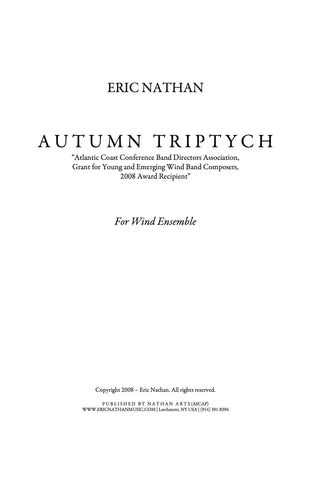"Evening Glow" (2008) - For Wind Ensemble
$ 100.00
For performance parts, please select from the drop-down menu above to rent
Instrumentation:
For Wind Ensemble
Commissioned by the Atlantic Coast Conference Band Directors Association:
Boston College, Clemson University, Duke University, Florida State University, Georgia Institute of Technology, North Carolina State University, University of Maryland, University of North Carolina, University of Miami, University of Virginia, Virginia Polytechnic Institute and State University, Wake Forest University.
Duration:
7 minutes
Program Note:
“Autumn Triptych” was commissioned by the twelve member schools of the Atlantic Coast Conference Band Directors Association. It is inspired by three paintings, each related to autumn: Jackson Pollock’s “Autumn Rhythm” (1950), John Atkinson Grimshaw’s “Evening Glow” (c.1884), and Georgia O’Keeffe’s “The Red Maple at Lake George” (1926). My piece does not seek to represent the paintings, but instead uses the paintings as a springboard for inspiration and musical form. It is my sincere hope that viewing the paintings will lend deeper insight into the meaning of the music and the music in some way may allow the viewer to see the art from a new perspective.
The three movements may either be performed individually or as a set (and may also be grouped in pairs).
II. “Evening Glow” is inspired by a painting of the same name by nineteenth-century British painter John Atkinson Grimshaw. I was immediately captivated by the peaceful, yet sorrowfully longing quality of the painting when I saw it during a visit to the Yale Center for British Art (where it resides in the Paul Mellon Collection). The painting shows a woman standing alone, looking down a winding road during the dusk of a fall evening. As the road recedes into the distance, the entire painting fades away into the golden glow of the autumn sunset.
I saw the road as a metaphor for time and for age. My piece puts two motifs in conflict with each other: the motif of the persistence of time with that of life. The two are in constant struggle over the course of the piece, until a chorale melody breaks through at the end, suspending the moment of Grimshaw’s autumn sunset, if only briefly, before allowing time to take over once again.
Score Preview:




